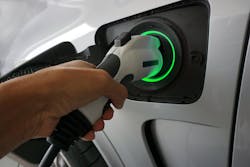Energy Saver: Take A Closer Look At Cascaded Efficiency
One of my friends — a lawyer — was the first person in our neighborhood to buy a Tesla. I admired the car, and he gave me a test ride, which impressed me even more. Then he told me how amazingly efficient the vehicle was. That was a dangerous thing to say to an engineer, especially one who specializes in energy efficiency.
I tried to be gentle with him. He was only a lawyer, after all; some electric motors can convert 98% of the incoming electrical energy to useful power. Unfortunately, that is only part of the story.
The power for the motor (98%) comes from a battery (90%), which draws power from a charger (90%), which gets its power from the electric grid (85%), which, in turn, gets its electricity from a power plant (35%). The numbers in parentheses are indicative energy efficiencies of each subsystem within what is actually a very large, cascaded system; the overall system efficiency is 0.98×0.90×0.90×0.85×0.35 ≈ 0.24, or 24%. Suddenly, the electric car doesn’t look so efficient. Note: Actual efficiencies can differ significantly from the indicative values shown above, especially for the power plant, which can use many different technologies and energy sources.
I’m not against electric vehicles. In fact, I now own a plug-in car myself. The point I want to emphasize is that we should consider complete systems, not individual components, when we make decisions about energy use or environmental impact. The “well to wheels” efficiency of a typical gasoline-engine car is calculated from a similar cascade. Its “cascade efficiency” is even lower than that of an electric vehicle.
Many cascaded systems exist within chemical plants and oil refineries, too. For example, applications that provide steam are very important in most manufacturing facilities. Their major subsystems are water preparation and treatment (90%), steam generation (92%), steam distribution (95%), and condensate recovery (96%). The overall system efficiency, in this case, is 0.90×0.92×0.95×0.96 ≈ 0.76, or 76%. In other words, of every 1 Btu (based on lower heating value, LHV) supplied to the steam system, only about 0.76 Btu actually is delivered to the ultimate consumer.
Site surveys often focus on the reducing demand — i.e., the quantity of heat, or the steam flow, required in various pieces of process equipment, such as reboilers and steam turbines. Steam savings often are possible by improving individual components (e.g., steam turbine upgrades), or by changing operating conditions (e.g., lowering the exhaust pressure of a steam turbine), or by process improvements that reduce the need for imported energy (e.g., heat recovery). These changes can save a lot of energy, but typically do not improve the efficiency of the steam system itself.
In water preparation and treatment, the most common major inefficiency is the absence of adequate preheating for deaerator feed water (See May 2019’s Energy Saver column “Get All Steamed Up,” ). Some deaerators consume 10% or more of the total steam make.
Large modern boilers typically are designed for more than 90% efficiency (LHV). The main heat loss is in the stack gas. Losses also exist through the boiler casing or shell, and in blowdown water. Good operation and maintenance, as well equipment upgrades, can minimize such losses and increase efficiency.
Energy losses in steam distribution mostly stem from steam leaks and steam trap failures, as well as heat losses through piping and vessel walls. These distribution losses can amount to 5% or more of the steam supplied. A 5% loss may not sound like much, but it can account for millions of dollars per year at a large plant. This can justify significant maintenance efforts.
Less than 80% of the condensate is recovered in most plants; the heat content of the lost condensate contributes to energy losses. In addition, recovered condensate often is cooled in the condensate return system, further increasing energy losses.
One major opportunity to improve overall system efficiency is by integrating the steam system and the power system in a “combined heat and power” or “cogeneration” system. This addresses the large inefficiency in thermal power plants by recovering rejected heat, which typically is then used to generate steam. This is a capital-intensive option, but can reduce the overall energy demand at some sites by 30% or more.
About the Author

Alan Rossiter
Energy Columnist
Alan Rossiter is a former contributor for Chemical Processing's Energy Saver column. He has more than 35 years of experience in process engineering and management, including eight years in plant technical support, design and research with Imperial Chemical Industries (ICI, United Kingdom) and nine years in energy efficiency and waste minimization consulting with Linnhoff March, before starting his own business. In 2019 he joined the University of Houston as Executive Director, External Relations for UH Energy. He is a chartered engineer (U.K.) and a registered professional engineer in the state of Texas. His latest book, Energy Management and Efficiency for the Process Industries, coauthored with Beth Jones, was published by John Wiley & Sons in 2015. He is a Fellow of the American Institute of Chemical Engineers and a Past Chair of the South Texas Section of the AIChE.
